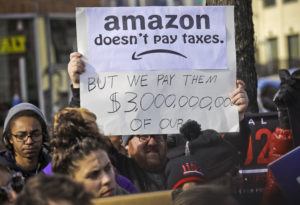Why You Shouldn’t Shop at Walmart on Black Friday
America’s largest employer is Walmart, whose average employee earns $8.81 an hour. A third of Walmart’s employees work less than 28 hours per week and don’t qualify for benefits.
This post originally ran on Robert Reich’s Web page, www.robertreich.org.
A half century ago America’s largest private-sector employer was General Motors, whose full-time workers earned an average hourly wage of around $50, in today’s dollars, including health and pension benefits.
Today, America’s largest employer is Walmart, whose average employee earns $8.81 an hour. A third of Walmart’s employees work less than 28 hours per week and don’t qualify for benefits.
There are many reasons for the difference – including globalization and technological changes that have shrunk employment in American manufacturing while enlarging it in sectors involving personal services, such as retail.
But one reason, closely related to this seismic shift, is the decline of labor unions in the United States. In the 1950s, over a third of private-sector workers belonged to a union. Today fewer than 7 percent do. As a result, the typical American worker no longer has the bargaining clout to get a sizeable share of corporate profits.
At the peak of its power and influence in the 1950s, the United Auto Workers could claim a significant portion of GM’s earnings for its members.
Walmart’s employees, by contrast, have no union to represent them. So they’ve had no means of getting much of the corporation’s earnings.
Walmart earned $16 billion last year (it just reported a 9 percent increase in earnings in the third quarter of 2012, to $3.6 billion), the lion’s share of which went instead to Walmart’s shareholders — including the family of its founder, Sam Walton, who earned on their Walmart stock more than the combined earnings of the bottom 40 percent of American workers.
Is this about to change? Despite decades of failed unionization attempts, Walmart workers are planning to strike or conduct some other form of protest outside at least 1,000 locations across the United States this Friday – so-called “Black Friday,” the biggest shopping day in America when the Christmas holiday buying season begins.
At the very least, the action gives Walmart employees a chance to air their grievances in public – not only lousy wages (as low at $8 an hour) but also unsafe and unsanitary working conditions, excessive hours, and sexual harassment. The result is bad publicity for the company exactly when it wants the public to think of it as Santa Claus. And the threatened strike, the first in 50 years, is gaining steam.
The company is fighting back. It has filed a complaint with the National Labor Relations Board to preemptively ban the Black Friday strikes. The complaint alleges that the pickets are illegal “representational” picketing designed to win recognition for the United Food & Commercial Workers (UFCW) union. Walmart’s workers say they’re protesting unfair labor practices rather than acting on behalf of the UFCW. If a court sides with Walmart, it could possibly issue an injunction blocking Black Friday’s pickets.
What happens at Walmart will have consequences extending far beyond the company. Other big box retailers are watching carefully. Walmart is their major competitor. Its pay scale and working conditions set the standard.
More broadly, the widening inequality reflected in the gap between the pay of Walmart workers and the returns to Walmart investors, including the Walton fammily, haunts the American economy.
Consumer spending is 70 percent of economic activity, but consumers are also workers. And as income and wealth continue to concentrate at the top, and the median wage continues to drop – it’s now 8 percent lower than it was in 2000 – a growing portion of the American workforce lacks the purchasing power to get the economy back to speed. Without a vibrant and growing middle class, Walmart itself won’t have the customers it needs.
Most new jobs in America are in personal services like retail, with low pay and bad hours. According to the Bureau of Labor and Statistics, the average full-time retail worker earns between $18,000 and $21,000 per year.
But if retail workers got a raise, would consumers have to pay higher prices to make up for it? A new study by the think tank Demos reports that raising the salary of all full-time workers at large retailers to $25,000 per year would lift more than 700,000 people out of poverty, at a cost of only a 1 percent price increase for customers.
And, in the end, retailers would benefit. According to the study, the cost of the wage increases to major retailers would be $20.8 billion — about one percent of the sector’s $2.17 trillion in total annual sales. But the study also estimates the increased purchasing power of lower-wage workers as a result of the pay raises would generate $4 billion to $5 billion in additional retail sales.
This seems like a good deal all around.
Robert B. Reich, chancellor’s professor of public policy at UC Berkeley, was secretary of labor in the Clinton administration. Time magazine named him one of the 10 most effective Cabinet secretaries of the last century. He has written 13 books, including the best-sellers “Aftershock” and “The Work of Nations.” His latest, “Beyond Outrage,” is now out in paperback. He is also a founding editor of The American Prospect magazine and chairman of Common Cause.
Your support matters…Independent journalism is under threat and overshadowed by heavily funded mainstream media.
You can help level the playing field. Become a member.
Your tax-deductible contribution keeps us digging beneath the headlines to give you thought-provoking, investigative reporting and analysis that unearths what's really happening- without compromise.
Give today to support our courageous, independent journalists.






You need to be a supporter to comment.
There are currently no responses to this article.
Be the first to respond.